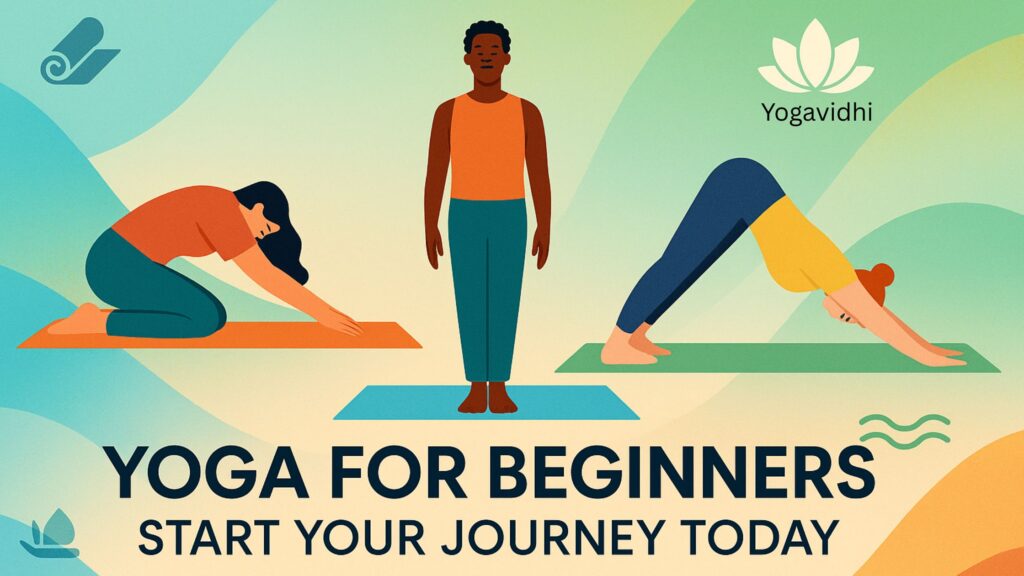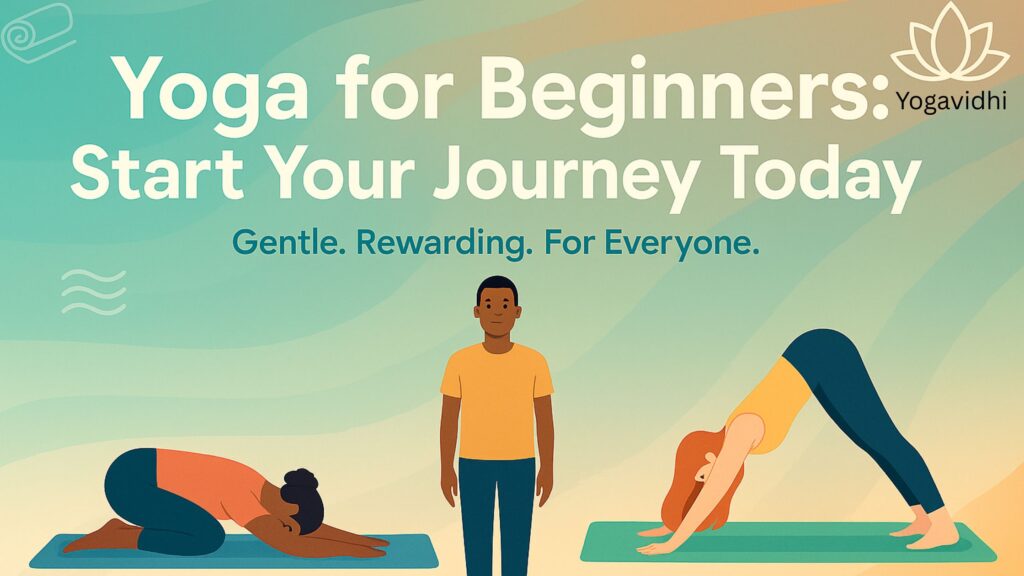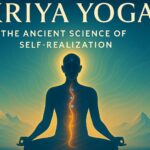If you’ve been curious about yoga but don’t know where to begin, you’re not alone. The practice of yoga may look intimidating at first—with all the poses, terminology, and flexibility—but yoga for beginners is surprisingly accessible, gentle, and deeply rewarding. Whether you’re looking to reduce stress, build flexibility, or simply improve your health, this ancient practice offers something for everyone.
In this guide, we’ll walk you through everything you need to know to start your yoga journey confidently. Let’s explore how yoga can transform your body, calm your mind, and awaken your spirit—even if you’ve never set foot on a yoga mat before.
Yoga for beginners emphasizes basic poses, breathing exercises, and gentle movements to enhance flexibility, strength, and balance. It also helps reduce stress and encourages relaxation, making it an ideal way to start your journey into the mind-body connection of yoga—no prior experience required.
Table of Contents
What is Yoga?
Yoga is an ancient practice that originated in India over 5,000 years ago. It’s more than just physical postures—it’s a holistic lifestyle that unites the body, mind, and spirit. The word “yoga” itself means “union.”
Over the years, yoga has evolved into various styles like Hatha, Vinyasa, Kundalini, Ashtanga, and Iyengar, each offering unique benefits. But don’t worry about mastering them all at once. For beginners, starting with gentle Hatha or beginner-level Vinyasa classes is ideal.
Why Choose Yoga for Beginners?
So, what makes yoga the perfect fitness and wellness choice for newcomers?
Here are a few compelling reasons:
- Stress relief through mindful breathing and meditation
- Improved flexibility and joint mobility
- Increased strength and balance
- Better posture and reduced back pain
- Boosted immunity and energy
- Better sleep and digestion
In short, practicing yoga for beginners is one of the most effective ways to nurture both your physical and mental health. You don’t need to be flexible or spiritual to begin—just a willingness to learn.
Common Myths About Yoga
Let’s clear up some common misconceptions that often stop beginners from taking that first step:
“I’m not flexible enough for yoga.”
That’s exactly why you should do yoga! Flexibility comes with consistent practice.
“Yoga is only for women.”
Absolutely not. Yoga is for everyone—men, women, children, and seniors.
“Yoga is a religion.”
Yoga is a spiritual practice, but not a religion. It’s about self-awareness and inner peace.
“You need expensive equipment.”
A simple mat and comfortable clothes are enough to get started.
Basic Tips for Yoga Beginners
Here are some beginner yoga tips to help you avoid overwhelm and stay motivated:
- Start slow: Choose beginner-friendly videos or classes.
- Be consistent: Even 10–15 minutes a day makes a difference.
- Breathe deeply: Connect your breath with your movement.
- Don’t compare: Everyone has a unique journey.
- Practice on an empty stomach: Allow 2 hours after eating.
What You Need to Start Practicing Yoga
You don’t need to invest a fortune to practice yoga for beginners. Here’s your basic toolkit:
- Yoga mat: Non-slip and supportive
- Comfortable clothes: Stretch-friendly and breathable
- Yoga blocks/strap (optional): Helps with alignment
- Water bottle and towel: Stay hydrated and dry
Beginner Yoga Poses to Try
Let’s get to the fun part—beginner yoga poses (asanas) that you can try today. These are easy on the joints and help build confidence.
1. Mountain Pose (Tadasana)
Stand tall with feet together and arms by your side. Ground your feet and engage your thighs.
2. Child’s Pose (Balasana)
A restful pose to stretch your back and calm the mind.
3. Cat-Cow Stretch (Marjaryasana-Bitilasana)
Improves spinal flexibility and warms up the body.
4. Downward-Facing Dog (Adho Mukha Svanasana)
Strengthens arms and legs, stretches the spine.
5. Cobra Pose (Bhujangasana)
Opens the chest and strengthens the spine.
6. Tree Pose (Vrikshasana)
Improves balance and concentration.
Start by holding each pose for 5–10 breaths, and gradually build up your stamina.
Read More: Kriya Yoga: Unlocking Inner Power Through Ancient Yogic Science
Read More: Yoga for Men: Build Strength, Flexibility & Mental Clarity
| Category | Details |
| What is Yoga? | A mind-body practice combining physical poses, breathing, and meditation |
| Ideal Yoga Styles | Hatha Yoga, Vinyasa Yoga, Iyengar Yoga |
| Top Benefits | Flexibility, strength, stress relief, better posture, mental clarity |
| Common Myths | Not flexible enough, only for women, needs expensive gear |
| Starter Tips | Begin slow, be consistent, focus on breath, practice on an empty stomach |
| Essential Equipment | Yoga mat, comfortable clothes, optional blocks/strap |
| Basic Poses | Mountain, Child’s Pose, Cat-Cow, Downward Dog, Cobra, Tree Pose |
| Breathing Techniques | Deep Belly Breathing, Alternate Nostril Breathing, Cooling Breath |
| Practice Setup at Home | Quiet space, regular time, calming music, online videos |
| Yoga Class Benefits | Professional guidance, community support, real-time feedback |
| Progress Indicators | More flexibility, better sleep, reduced anxiety, increased energy |
| Mistakes to Avoid | Overstretching, skipping warm-up, comparing with others |
| Lifestyle Support Tips | Eat light, hydrate, sleep well, stay mindful |
| Recommended Frequency | 2–3 times a week initially, then build up to daily practice |
Breathing Techniques (Pranayama) for Beginners
Breath is the bridge between your body and mind. These simple pranayama techniques are perfect for calming anxiety and improving focus:
1. Deep Belly Breathing
Place your hands on your belly and inhale deeply, expanding your abdomen.
2. Alternate Nostril Breathing (Nadi Shodhana)
Balances the nervous system and clears mental fog.
3. Cooling Breath (Sheetali)
Reduces heat and stress during warm seasons.
Try these after your yoga session or any time you feel stressed.
How to Build a Home Yoga Practice
Creating a consistent home practice is key for beginners. Here’s how to make it easier:
- Choose a quiet, clutter-free space
- Practice at the same time daily (morning or evening)
- Light a candle or play soft music to set the mood
- Follow a YouTube beginner series or yoga app
- Keep a journal to track your feelings and progress
Should You Join a Yoga Class?
If you’re unsure about practicing alone, joining a beginner class can help with:
- Proper alignment
- Motivation through community
- Live guidance and support
Look for “yoga for beginners near me” or start with online options like Youtube for structured guidance.
How to Track Progress Without Stress
Yoga isn’t about perfection—it’s about progress. Here are ways to notice improvements:
- Increased energy and flexibility
- Better sleep and digestion
- Less anxiety and more calm
- Confidence in trying new poses
Celebrate small wins. You’re showing up—and that’s enough.
Mistakes Beginners Should Avoid
Here are some common pitfalls to watch out for:
- Skipping warm-ups
- Forcing yourself into poses
- Ignoring breath
- Practicing inconsistently
- Comparing with others
Avoiding these mistakes helps you stay injury-free and enjoy your yoga practice.
Supporting Your Yoga Journey with Lifestyle Changes
Yoga is not just about the mat. Supporting your practice with healthy habits enhances its benefits:
- Eat light before practice
- Stay hydrated
- Get adequate sleep
- Limit screen time before bed
- Practice mindfulness in daily activities
Bonus: Try integrating light Ayurvedic tips or herbal teas to deepen the wellness effect.
Final Thoughts: Begin Your Yoga Journey Today
Starting yoga doesn’t require fancy gear or a studio membership. All it takes is a little curiosity and a commitment to your well-being. With consistent practice, yoga for beginners can help you feel stronger, calmer, and more connected to yourself.
So roll out your mat, take a deep breath, and begin. Your body and mind will thank you.

Ready to Begin?
- Try a 7-day beginner yoga challenge
- Subscribe for yoga tips and pose breakdowns
Frequently Asked Questions (FAQs):
Q. How often should a beginner practice yoga?
Ans: Start with 2–3 times per week and gradually build to daily practice as your body adapts.
Q. Can I do yoga at home as a beginner?
Ans: Absolutely! Home practice is convenient and effective with the right guidance.
Q. Do I need to be flexible to start yoga?
Ans: No. Flexibility improves with regular practice—it’s not a requirement.
Q. What type of yoga is best for beginners?
Ans: Hatha yoga or beginner-level Vinyasa classes are great starting points.
Q. Is yoga enough for weight loss?
Ans: Yoga supports weight loss by reducing stress, improving metabolism, and encouraging mindful eating.
Q. How do you explain yoga to beginners?
Ans: Yoga isn’t about being extremely flexible or twisting your body into complicated shapes. It’s about mindful breathing, discovering inner strength through meditation, and building freedom in your body with simple yoga postures. That’s really all it takes.
Q. What is beginner yoga?
Ans: Yoga Level 1 – Beginner
When you come across a Yoga Level 1 Beginner class, you might assume it’s meant solely for complete novices. However, Level 1 yoga typically expects you to have a basic familiarity with foundational poses, such as knowing how to support your spine in Cobra Pose.
Declaration Note:
We use third-party videos and images on https://yogavidhi.com/ for educational and illustrative purposes. All rights belong to their respective owners. No copyright infringement is intended.



